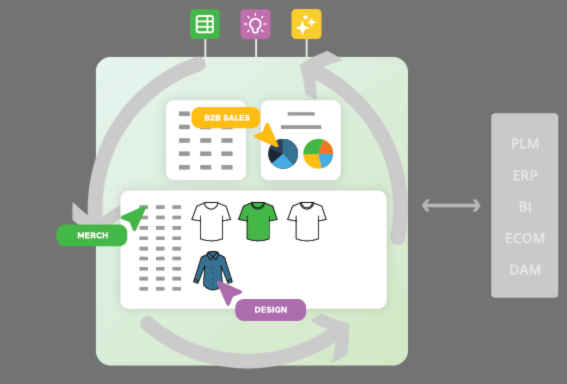In this piece, we’ll explore the challenges involved in speeding up time-to-market, and specifically how VibeIQ can help retail, fashion and apparel brands streamline their processes, cut down the go-to-market calendar, and ultimately outperform their competitors.
Challenges of Speeding Up Time-to-Market
Complexity of Pre-Production Work
One of the biggest challenges in reducing time-to-market lies in the pre-production stage of the go-to-market process, which can consume anywhere from 50% or more of the overall timeline.
This pre-production process encompasses all the complex, manual, and iterative work involved in product creation, including creative design, design collaboration, line planning, and cross-functional collaboration. It’s during this stage that delays often occur, as teams work to align on product concepts, finalize designs, and prepare for production.
These teams often operate in a very manual and archaic manner, relying on disparate spreadsheets, presentation decks, physical and digital whiteboards, and design software that are not connected to one another. This disconnection creates significant challenges for cross-functional collaboration, as each team is essentially working in its own silo.
Complicating things further, the product information and product imagery stored in these files and documents must be manually created and maintained, a process that is not only time-consuming but also prone to errors. These challenges are compounded by the complexity of managing multiple seasons concurrently—teams often juggle two, three, or even four seasons at once, further slowing down the process.
Moreover, the accuracy and depth of any product attributes associated with individual items across a product line cannot be trusted, if it exists at all. This lack of reliable data creates additional delays as teams spend time verifying information or redoing work to ensure accuracy. The end result is a cumbersome pre-production process that consumes a disproportionate amount of time and becomes a major obstacle in reducing time-to-market. Moreover, since pre-production processes are chaotic, manual, and lengthy, downstream teams can’t start sooner, leading to production risks.
Balancing Speed with Quality and Brand Integrity
While the need for speed is clear, it’s equally important to maintain product quality and brand integrity. Rushing products to market without proper vetting can lead to quality control issues, brand misalignment, and ultimately, dissatisfied customers. For merchandising and product leaders, the challenge is to strike the right balance between accelerating time-to-market and ensuring that all products meet the brand’s high standards.
Key Strategies for Accelerating Time-to-Market
Streamlining the Pre-Production Process with VibeIQ
Since many teams manage their pre-production data in disconnected documents (Excel files for line plans, product line presentations in Powerpoint, product imagery in digital whiteboards like Miro), collaborating with the same product data is a challenge that decreases team productivity and velocity.
VibeIQ’s Digital Product Workspace, a suite of connected, user-friendly collaboration apps, ensures that all teams—merchandising, design, sales, and product—are working on and referencing the same product information, assets, and assortment definitions throughout the iterative process. This shared workspace enhances collaboration, reduces miscommunication, and ensures that all teams are aligned on timelines and priorities, helping to accelerate the pre-production process.

Make Enterprise Data and Analytics Available at the Point of Collaboration and Decision-Making
With VibeIQ, critical data from multiple enterprise systems (PLM, ERP, BI, e-Commerce) is made available right at the point of collaboration and decision-making. This real-time access to data helps teams make more informed decisions faster, reducing the time needed to collect product line data across different systems, review and then approve those product lines. By integrating data-driven insights into every step of the process, VibeIQ ensures that decisions are based on the most accurate and up-to-date information.
Automate Manual Tasks and Save Team Member Time
One of the most effective ways to reduce time-to-market is by automating the manual tasks that consume so much of your team’s time. With VibeIQ, you can automate the collection of information, the creation of presentations such as visual line boards, and the entry of data into multiple systems. This not only saves countless hours but also reduces errors, improves accuracy, and frees up your team to focus on more strategic activities.
Increase Agility and Ability to React to Changes
For retail, fashion and apparel brands, the ability to quickly adapt to changes is crucial. Because VibeIQ is a Digital Product Workspace that marries product visuals with associated product data and because this combination is always up-to-date, teams can easily collect feedback early and often. This enables them to make product and product line adjustments without worrying about misalignment or lack of visibility. This agility is key to staying ahead of the competition and meeting tight deadlines that can’t be achieved without a system that doesn’t combine product visuals and data that is always kept up-to-date.
Access Attributed Product and Line Data Earlier in the Process
VibeIQ’s Digital Product Workspace allows teams to evolve their earliest ideas into attributed concepts and products in a structured way. What was once locked in Excel sheets and PowerPoint presentations is now accessible and measurable to everyone, at all times, unlocking valuable data and insights earlier in the process. This early access to data helps teams identify potential issues sooner – such as over-assortment or low adoption rates- and make necessary adjustments before they become critical roadblocks.
Make Digital Assets Available to All Teams and Processes
As brands shift to digital product workflows, it’s essential that all digital assets are available to the teams who need them to provide rapid feedback or make critical decisions. VibeIQ ensures that digital assets are easily accessible, allowing teams to work more efficiently and make informed decisions quickly, further reducing time-to-market.
The Competitive Advantage of Reduced Time-to-Market
Capturing Market Share with Speed
Reducing time-to-market enables fashion brands to be first to market with new trends, a crucial advantage in the fast-paced fashion industry. By being faster, brands can capture market share, dominate their categories, and set themselves apart as leaders in trendsetting. Speed not only drives higher sales volumes but also strengthens brand positioning, making it harder for competitors to catch up.
Maximizing Full-Price Sales and Profit Margins
A faster time-to-market allows brands to align product launches with peak consumer demand, maximizing full-price sales and improving profit margins. By reducing the time it takes to bring products to market, brands can avoid markdowns, preserve their brand value, and deliver stronger financial performance.
Enhancing Brand Perception and Consumer Loyalty
Being consistently fast to market enhances brand perception, positioning the brand as a leader in innovation and responsiveness. This speed builds consumer loyalty, as customers trust the brand to deliver the latest trends quickly and reliably. In a crowded market, this ability to consistently meet consumer expectations sets the brand apart and drives repeat purchases.
How VibeIQ Enables Faster Time-to-Market
VibeIQ’s Centralized Digital Product Workspace
VibeIQ’s platform centralizes all aspects of the pre-production process, enabling teams to work more efficiently and reduce time-to-market. By providing a single source of truth for product information, VibeIQ ensures that all teams are aligned and working towards the same goals. This centralization accelerates the go-to-market process, helping brands bring products to market faster.
Real-Time Analytics and Workflow Optimization
VibeIQ’s real-time analytics capabilities provide the insights needed to optimize workflows, identify bottlenecks, and ensure that product lines are on track to meet launch dates. These insights enable faster decision-making, more efficient project management, and the ability to quickly adjust plans to stay on schedule. With VibeIQ, brands can confidently manage their time-to-market, knowing that they have the data and tools needed to succeed.
Agile Workflows and Process Automation
VibeIQ supports agile workflows, enabling teams to iterate quickly, adapt to changes in real time, and maintain flexibility in their product development processes. By automating routine tasks and reducing manual effort, VibeIQ speeds up the development cycle, ultimately contributing to a faster time-to-market. This agility allows brands to respond quickly to market changes and consumer demand, ensuring that they stay ahead of the competition.
The Strategic Advantage of Accelerated Time-to-Market
Reducing time-to-market is not just about being faster; it’s about gaining a significant competitive advantage in retail and fashion and apparel industries. By streamlining pre-production processes, enhancing collaboration, and leveraging real-time data, fashion brands can accelerate their go-to-market timelines and outperform their competitors. VibeIQ’s platform provides the tools and capabilities needed to achieve these goals, empowering your team to bring products to market faster and with greater success.
Explore how VibeIQ can help your team reduce time-to-market and gain a competitive edge in the fashion industry.
Get in touch with us to learn more about our platform and discover how it can transform your merchandising strategy and drive business growth.



